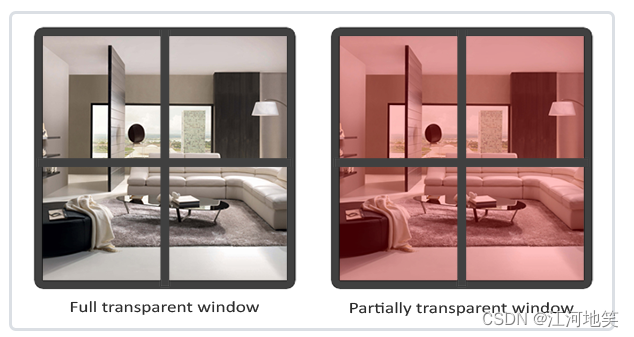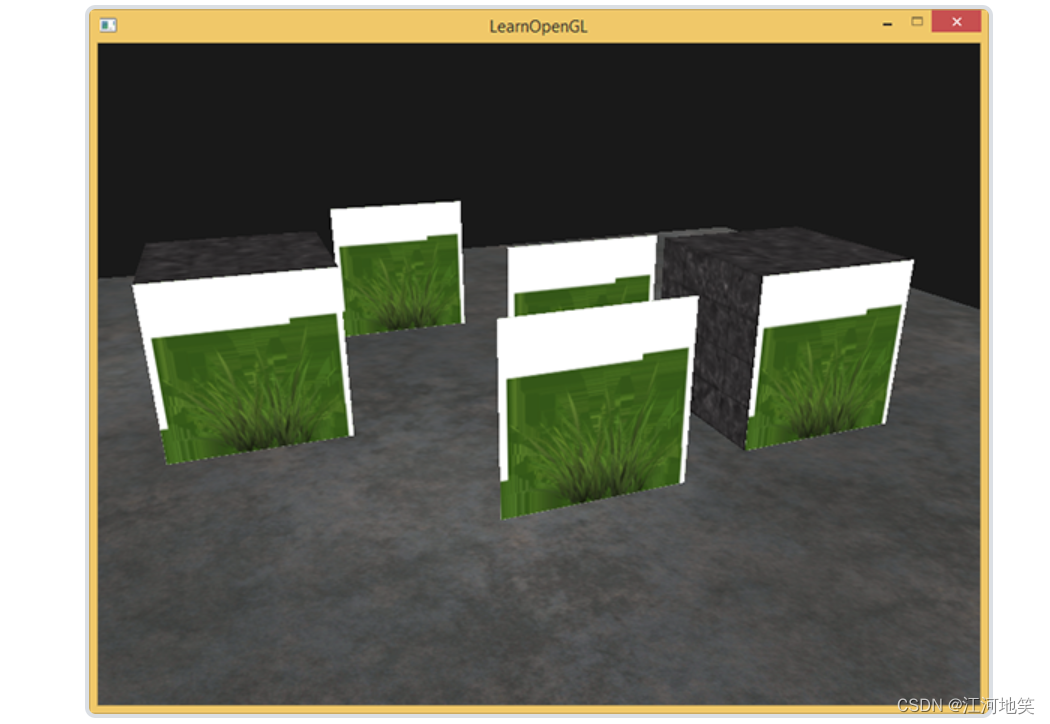本文主要是介绍OpenGL_Learn19(混合),希望对大家解决编程问题提供一定的参考价值,需要的开发者们随着小编来一起学习吧!
OpenGL中,混合(Blending)通常是实现物体透明度(Transparency)的一种技术。透明就是说一个物体(或者其中的一部分)不是纯色(Solid Color)的,它的颜色是物体本身的颜色和它背后其它物体的颜色的不同强度结合。一个有色玻璃窗是一个透明的物体,玻璃有它自己的颜色,但它最终的颜色还包含了玻璃之后所有物体的颜色。这也是混合这一名字的出处,我们混合(Blend)(不同物体的)多种颜色为一种颜色。所以透明度能让我们看穿物体。

比如草,一般都是纹理贴到正方形纸片上,会导致如下的效果

出现这种情况是因为OpenGL默认是不知道怎么处理alpha值的,更不知道什么时候应该丢弃片段。
blending.vs#version 330 core
layout(location=0) in vec3 aPos;
layout(location=1) in vec2 aTexCoords;out vec2 TexCoords;uniform mat4 model;
uniform mat4 view;
uniform mat4 projection;void main(){TexCoords=aTexCoords;gl_Position=projection*view*model*vec4(aPos,1.0);
}blending.fs#version 330 core
out vec4 FragColor;in vec2 TexCoords;uniform sampler2D texture0;void main(){vec4 texColor=texture(texture0,TexCoords);if(texColor.a<0.1){discard;}FragColor=texColor;
}
#include <glad/glad.h>
#include <GLFW/glfw3.h>#include <glm/glm.hpp>
#include <glm/gtc/matrix_transform.hpp>
#include <glm/gtc/type_ptr.hpp>#include "shader.h"
#include "camera.h"
#include "model.h"#include <iostream>void framebuffer_size_callback(GLFWwindow* window, int width, int height);
void mouse_callback(GLFWwindow* window, double xpos, double ypos);
void scroll_callback(GLFWwindow* window, double xoffset, double yoffset);
void processInput(GLFWwindow* window);
unsigned int loadTexture(const char* path);// settings
const unsigned int SCR_WIDTH = 800;
const unsigned int SCR_HEIGHT = 600;// camera
Camera camera(glm::vec3(0.0f, 0.0f, 3.0f));
float lastX = (float)SCR_WIDTH / 2.0;
float lastY = (float)SCR_HEIGHT / 2.0;
bool firstMouse = true;// timing
float deltaTime = 0.0f;
float lastFrame = 0.0f;int main()
{// glfw: initialize and configure// ------------------------------glfwInit();glfwWindowHint(GLFW_CONTEXT_VERSION_MAJOR, 3);glfwWindowHint(GLFW_CONTEXT_VERSION_MINOR, 3);glfwWindowHint(GLFW_OPENGL_PROFILE, GLFW_OPENGL_CORE_PROFILE);#ifdef __APPLE__glfwWindowHint(GLFW_OPENGL_FORWARD_COMPAT, GL_TRUE);
#endif// glfw window creation// --------------------GLFWwindow* window = glfwCreateWindow(SCR_WIDTH, SCR_HEIGHT, "LearnOpenGL", NULL, NULL);if (window == NULL){std::cout << "Failed to create GLFW window" << std::endl;glfwTerminate();return -1;}glfwMakeContextCurrent(window);glfwSetFramebufferSizeCallback(window, framebuffer_size_callback);glfwSetCursorPosCallback(window, mouse_callback);glfwSetScrollCallback(window, scroll_callback);// tell GLFW to capture our mouseglfwSetInputMode(window, GLFW_CURSOR, GLFW_CURSOR_DISABLED);// glad: load all OpenGL function pointers// ---------------------------------------if (!gladLoadGLLoader((GLADloadproc)glfwGetProcAddress)){std::cout << "Failed to initialize GLAD" << std::endl;return -1;}// configure global opengl state// -----------------------------glEnable(GL_DEPTH_TEST);// build and compile shaders// -------------------------Shader shader("blending.vs", "blending.fs");// set up vertex data (and buffer(s)) and configure vertex attributes// ------------------------------------------------------------------float cubeVertices[] = {// positions // texture Coords-0.5f, -0.5f, -0.5f, 0.0f, 0.0f,0.5f, -0.5f, -0.5f, 1.0f, 0.0f,0.5f, 0.5f, -0.5f, 1.0f, 1.0f,0.5f, 0.5f, -0.5f, 1.0f, 1.0f,-0.5f, 0.5f, -0.5f, 0.0f, 1.0f,-0.5f, -0.5f, -0.5f, 0.0f, 0.0f,-0.5f, -0.5f, 0.5f, 0.0f, 0.0f,0.5f, -0.5f, 0.5f, 1.0f, 0.0f,0.5f, 0.5f, 0.5f, 1.0f, 1.0f,0.5f, 0.5f, 0.5f, 1.0f, 1.0f,-0.5f, 0.5f, 0.5f, 0.0f, 1.0f,-0.5f, -0.5f, 0.5f, 0.0f, 0.0f,-0.5f, 0.5f, 0.5f, 1.0f, 0.0f,-0.5f, 0.5f, -0.5f, 1.0f, 1.0f,-0.5f, -0.5f, -0.5f, 0.0f, 1.0f,-0.5f, -0.5f, -0.5f, 0.0f, 1.0f,-0.5f, -0.5f, 0.5f, 0.0f, 0.0f,-0.5f, 0.5f, 0.5f, 1.0f, 0.0f,0.5f, 0.5f, 0.5f, 1.0f, 0.0f,0.5f, 0.5f, -0.5f, 1.0f, 1.0f,0.5f, -0.5f, -0.5f, 0.0f, 1.0f,0.5f, -0.5f, -0.5f, 0.0f, 1.0f,0.5f, -0.5f, 0.5f, 0.0f, 0.0f,0.5f, 0.5f, 0.5f, 1.0f, 0.0f,-0.5f, -0.5f, -0.5f, 0.0f, 1.0f,0.5f, -0.5f, -0.5f, 1.0f, 1.0f,0.5f, -0.5f, 0.5f, 1.0f, 0.0f,0.5f, -0.5f, 0.5f, 1.0f, 0.0f,-0.5f, -0.5f, 0.5f, 0.0f, 0.0f,-0.5f, -0.5f, -0.5f, 0.0f, 1.0f,-0.5f, 0.5f, -0.5f, 0.0f, 1.0f,0.5f, 0.5f, -0.5f, 1.0f, 1.0f,0.5f, 0.5f, 0.5f, 1.0f, 0.0f,0.5f, 0.5f, 0.5f, 1.0f, 0.0f,-0.5f, 0.5f, 0.5f, 0.0f, 0.0f,-0.5f, 0.5f, -0.5f, 0.0f, 1.0f};float planeVertices[] = {// positions // texture Coords 5.0f, -0.5f, 5.0f, 2.0f, 0.0f,-5.0f, -0.5f, 5.0f, 0.0f, 0.0f,-5.0f, -0.5f, -5.0f, 0.0f, 2.0f,5.0f, -0.5f, 5.0f, 2.0f, 0.0f,-5.0f, -0.5f, -5.0f, 0.0f, 2.0f,5.0f, -0.5f, -5.0f, 2.0f, 2.0f};float transparentVertices[] = {// positions // texture Coords (swapped y coordinates because texture is flipped upside down)0.0f, 0.5f, 0.0f, 0.0f, 0.0f,0.0f, -0.5f, 0.0f, 0.0f, 1.0f,1.0f, -0.5f, 0.0f, 1.0f, 1.0f,0.0f, 0.5f, 0.0f, 0.0f, 0.0f,1.0f, -0.5f, 0.0f, 1.0f, 1.0f,1.0f, 0.5f, 0.0f, 1.0f, 0.0f};// cube VAOunsigned int cubeVAO, cubeVBO;glGenBuffers(1, &cubeVBO);glBindBuffer(GL_ARRAY_BUFFER, cubeVBO);glBufferData(GL_ARRAY_BUFFER, sizeof(cubeVertices), &cubeVertices, GL_STATIC_DRAW);glGenVertexArrays(1, &cubeVAO);glBindVertexArray(cubeVAO);glEnableVertexAttribArray(0);glVertexAttribPointer(0, 3, GL_FLOAT, GL_FALSE, 5 * sizeof(float), (void*)0);glEnableVertexAttribArray(1);glVertexAttribPointer(1, 2, GL_FLOAT, GL_FALSE, 5 * sizeof(float), (void*)(3 * sizeof(float)));// plane VAOunsigned int planeVAO, planeVBO;glGenBuffers(1, &planeVBO);glBindBuffer(GL_ARRAY_BUFFER, planeVBO);glBufferData(GL_ARRAY_BUFFER, sizeof(planeVertices), &planeVertices, GL_STATIC_DRAW);glGenVertexArrays(1, &planeVAO);glBindVertexArray(planeVAO);glEnableVertexAttribArray(0);glVertexAttribPointer(0, 3, GL_FLOAT, GL_FALSE, 5 * sizeof(float), (void*)0);glEnableVertexAttribArray(1);glVertexAttribPointer(1, 2, GL_FLOAT, GL_FALSE, 5 * sizeof(float), (void*)(3 * sizeof(float)));// transparent VAOunsigned int transparentVAO, transparentVBO;glGenBuffers(1, &transparentVBO);glBindBuffer(GL_ARRAY_BUFFER, transparentVBO);glBufferData(GL_ARRAY_BUFFER, sizeof(transparentVertices), transparentVertices, GL_STATIC_DRAW);glGenVertexArrays(1, &transparentVAO);glBindVertexArray(transparentVAO);glEnableVertexAttribArray(0);glVertexAttribPointer(0, 3, GL_FLOAT, GL_FALSE, 5 * sizeof(float), (void*)0);glEnableVertexAttribArray(1);glVertexAttribPointer(1, 2, GL_FLOAT, GL_FALSE, 5 * sizeof(float), (void*)(3 * sizeof(float)));//解绑glBindVertexArray(0);// load textures// -------------std::string t1 = R"(D:\CPlusProject\LearnOpenGL\Data\LearnOpenGL-master\resources\textures\marble.jpg)";std::string t2 = R"(D:\CPlusProject\LearnOpenGL\Data\LearnOpenGL-master\resources\textures\metal.png)";std::string t3 = R"(D:\CPlusProject\LearnOpenGL\Data\LearnOpenGL-master\resources\textures\grass.png)";unsigned int cubeTexture = loadTexture(t1.c_str());unsigned int floorTexture = loadTexture(t2.c_str());unsigned int transparentTexture = loadTexture(t3.c_str());// transparent vegetation locations// --------------------------------vector<glm::vec3> vegetation{glm::vec3(-1.5f, 0.0f, -0.48f),glm::vec3(1.5f, 0.0f, 0.51f),glm::vec3(0.0f, 0.0f, 0.7f),glm::vec3(-0.3f, 0.0f, -2.3f),glm::vec3(0.5f, 0.0f, -0.6f)};// shader configuration// --------------------shader.use();shader.setInt("texture0", 0);// render loop// -----------while (!glfwWindowShouldClose(window)){// per-frame time logic// --------------------float currentFrame = static_cast<float>(glfwGetTime());deltaTime = currentFrame - lastFrame;lastFrame = currentFrame;// input// -----processInput(window);// render// ------glClearColor(0.1f, 0.1f, 0.1f, 1.0f);glClear(GL_COLOR_BUFFER_BIT | GL_DEPTH_BUFFER_BIT);// draw objectsshader.use();glm::mat4 projection = glm::perspective(glm::radians(camera.Zoom), (float)SCR_WIDTH / (float)SCR_HEIGHT, 0.1f, 100.0f);glm::mat4 view = camera.GetViewMatrix();glm::mat4 model = glm::mat4(1.0f);shader.setMat4("projection", projection);shader.setMat4("view", view);// cubesglBindVertexArray(cubeVAO);glActiveTexture(GL_TEXTURE0);glBindTexture(GL_TEXTURE_2D, cubeTexture);model = glm::translate(model, glm::vec3(-1.0f, 0.0f, -1.0f));shader.setMat4("model", model);glDrawArrays(GL_TRIANGLES, 0, 36);model = glm::mat4(1.0f);model = glm::translate(model, glm::vec3(2.0f, 0.0f, 0.0f));shader.setMat4("model", model);glDrawArrays(GL_TRIANGLES, 0, 36);// floorglBindVertexArray(planeVAO);glBindTexture(GL_TEXTURE_2D, floorTexture);model = glm::mat4(1.0f);shader.setMat4("model", model);glDrawArrays(GL_TRIANGLES, 0, 6);// vegetationglBindVertexArray(transparentVAO);glBindTexture(GL_TEXTURE_2D, transparentTexture);for (unsigned int i = 0; i < vegetation.size(); i++){model = glm::mat4(1.0f);model = glm::translate(model, vegetation[i]);shader.setMat4("model", model);glDrawArrays(GL_TRIANGLES, 0, 6);}// glfw: swap buffers and poll IO events (keys pressed/released, mouse moved etc.)// -------------------------------------------------------------------------------glfwSwapBuffers(window);glfwPollEvents();}// optional: de-allocate all resources once they've outlived their purpose:// ------------------------------------------------------------------------glDeleteVertexArrays(1, &cubeVAO);glDeleteVertexArrays(1, &planeVAO);glDeleteBuffers(1, &cubeVBO);glDeleteBuffers(1, &planeVBO);glfwTerminate();return 0;
}// process all input: query GLFW whether relevant keys are pressed/released this frame and react accordingly
// ---------------------------------------------------------------------------------------------------------
void processInput(GLFWwindow* window)
{if (glfwGetKey(window, GLFW_KEY_ESCAPE) == GLFW_PRESS)glfwSetWindowShouldClose(window, true);if (glfwGetKey(window, GLFW_KEY_W) == GLFW_PRESS)camera.ProcessKeyboard(FORWARD, deltaTime);if (glfwGetKey(window, GLFW_KEY_S) == GLFW_PRESS)camera.ProcessKeyboard(BACKWARD, deltaTime);if (glfwGetKey(window, GLFW_KEY_A) == GLFW_PRESS)camera.ProcessKeyboard(LEFT, deltaTime);if (glfwGetKey(window, GLFW_KEY_D) == GLFW_PRESS)camera.ProcessKeyboard(RIGHT, deltaTime);
}// glfw: whenever the window size changed (by OS or user resize) this callback function executes
// ---------------------------------------------------------------------------------------------
void framebuffer_size_callback(GLFWwindow* window, int width, int height)
{// make sure the viewport matches the new window dimensions; note that width and // height will be significantly larger than specified on retina displays.glViewport(0, 0, width, height);
}// glfw: whenever the mouse moves, this callback is called
// -------------------------------------------------------
void mouse_callback(GLFWwindow* window, double xposIn, double yposIn)
{float xpos = static_cast<float>(xposIn);float ypos = static_cast<float>(yposIn);if (firstMouse){lastX = xpos;lastY = ypos;firstMouse = false;}float xoffset = xpos - lastX;float yoffset = lastY - ypos; // reversed since y-coordinates go from bottom to toplastX = xpos;lastY = ypos;camera.ProcessMouseMovement(xoffset, yoffset);
}// glfw: whenever the mouse scroll wheel scrolls, this callback is called
// ----------------------------------------------------------------------
void scroll_callback(GLFWwindow* window, double xoffset, double yoffset)
{camera.ProcessMouseScroll(static_cast<float>(yoffset));
}// utility function for loading a 2D texture from file
// ---------------------------------------------------
unsigned int loadTexture(char const* path)
{unsigned int textureID;glGenTextures(1, &textureID);int width, height, nrComponents;unsigned char* data = stbi_load(path, &width, &height, &nrComponents, 0);if (data){GLenum format;if (nrComponents == 1)format = GL_RED;else if (nrComponents == 3)format = GL_RGB;else if (nrComponents == 4)format = GL_RGBA;glBindTexture(GL_TEXTURE_2D, textureID);glTexImage2D(GL_TEXTURE_2D, 0, format, width, height, 0, format, GL_UNSIGNED_BYTE, data);glGenerateMipmap(GL_TEXTURE_2D);glTexParameteri(GL_TEXTURE_2D, GL_TEXTURE_WRAP_S, format == GL_RGBA ? GL_CLAMP_TO_EDGE : GL_REPEAT); // for this tutorial: use GL_CLAMP_TO_EDGE to prevent semi-transparent borders. Due to interpolation it takes texels from next repeat glTexParameteri(GL_TEXTURE_2D, GL_TEXTURE_WRAP_T, format == GL_RGBA ? GL_CLAMP_TO_EDGE : GL_REPEAT);glTexParameteri(GL_TEXTURE_2D, GL_TEXTURE_MIN_FILTER, GL_LINEAR_MIPMAP_LINEAR);glTexParameteri(GL_TEXTURE_2D, GL_TEXTURE_MAG_FILTER, GL_LINEAR);stbi_image_free(data);}else{std::cout << "Texture failed to load at path: " << path << std::endl;stbi_image_free(data);}return textureID;
}
这篇关于OpenGL_Learn19(混合)的文章就介绍到这儿,希望我们推荐的文章对编程师们有所帮助!









